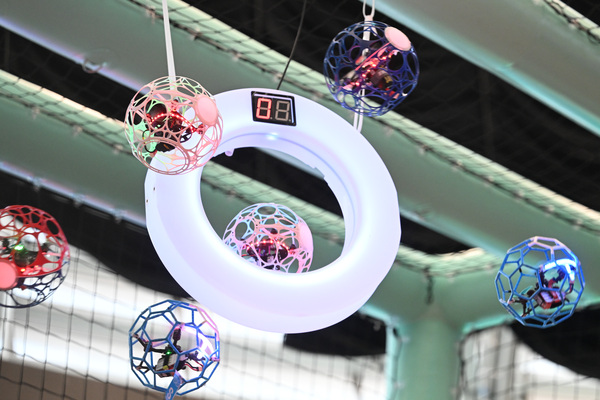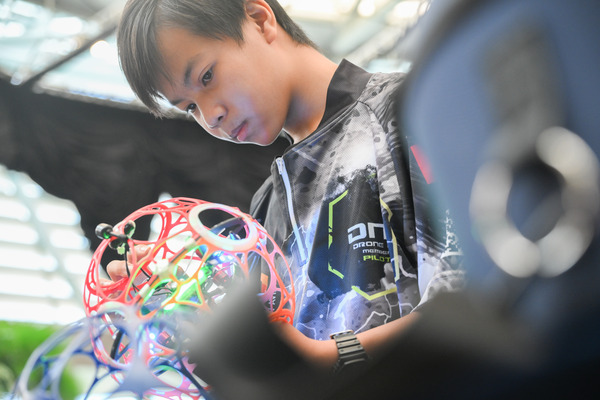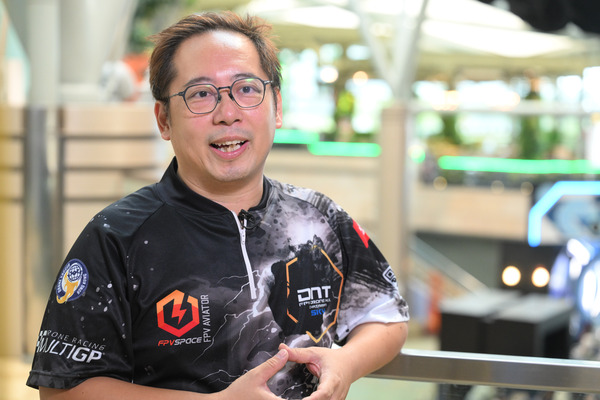Drone sports add to low-altitude buzz
Alongside the Government’s push to develop Hong Kong’s low-altitude economy, drone sports have been gaining in popularity.
Secondary 2 student Lawrence Tong is a devotee of drone soccer who already has rich drone experience under his belt. He recently joined four teammates to compete in a five-a-side drone soccer tournament at Cyberport.
“I enjoy drone soccer because it helps me improve communication and teamwork, as well as my problem-solving and observation skills,” he said.
The team-based aerial sport involves pilots manoeuvring drones encased in spherical shields. Some pilots act as defenders and others as strikers, and the aim is to score by flying through the opponent’s goal hoop, which is suspended in the air.
Lawrence began learning to programme drones in Primary 1, and was introduced to drone soccer by his extracurricular activity teacher in Primary 4. Now captain of his school’s drone club, he is proficient in everything from drone maintenance to piloting and in-game tactical adaptation.
Drone dream
At the tournament, Lawrence analysed the opposing teams before each match and adjusted the drone setups. In between matches, he checked for damage and had to perform quick repairs, such as replacing broken propellers.
He emphasised that teamwork is the key to success in the game, explaining that if a defensive player is knocked out by an opponent, other pilots must quickly shift positions to cover.
Though his team trailed early on in the competition, they eventually found their rhythm and secured fourth place.
Looking ahead, Lawrence said he would like to study drone-related subjects if he gets the chance.
“For now, I will prioritise my studies while continuing to develop my interests. But if I could pursue a career in this field in the future, that would be a dream come true.”
Nurturing talent
The tournament was hosted by the DNT FPV Drone Association Hong Kong, China, and drew participants from both secondary and primary schools across Hong Kong, as well as other cities in the Greater Bay Area.
The association’s chairman Sky Yeung highlighted that everything about the event – from the competition rules and drone specifications to the size of the goal hoop – aligned with the standards followed by the 15th National Games, currently underway in Hong Kong, Macau and Guangdong. For the first time, the roster of mass participation events at the games includes an aircraft modelling competition, featuring drone soccer, drone racing and indoor radio-controlled air combat.
He added that the Cyberport tournament also aimed to give more young people a taste of drone sports and build their problem-solving capabilities.
“For different drones, how to gain the balance, how to have a longer flight time – these all are related to aerodynamics and also the drone technology.
“So the students need to know how to control the drone manually. They need to modify the drone – for example, the flight time, battery lifetime, ESC (electronic speed controller), and PID (Proportional-Integral-Derivative control).”
He added that these skills have practical applications beyond the context of sports – from search and rescue operations to cargo lifting and pipe inspections.
Currently, the drone association provides drone-related courses and activities to around 150 local schools.
Mr Yeung believes that Hong Kong youths have immense potential when it comes to innovation and creativity, and that nurturing young drone sports talent can contribute to the city’s low-altitude economy in the future.
Dedicated facility
Drone sports encompasses a wide variety of formats besides soccer – drone racing, for example, involves pilots flying high-speed drones through obstacle courses.
Racing drones, also known as FPV (first-person view) drones, stream live video from an onboard camera to a pilot’s goggles and can reach speeds of up to 300km per hour. Accordingly, they require venues with high safety standards, and – as Mr Yeung explained – until recently this meant participants often had to travel to other cities in the Greater Bay Area in order to train.
That changed, however, with the opening of Hong Kong’s first drone sports centre at Cyberport in October. The drone association now makes use of this enclosed and safe environment to conduct drone training and explore real-world applications.
Cyberport Management Company Head of Engineering Services Eddie Lok reported that the facility has received a keen response in terms of bookings from drone sports enthusiasts and training providers, and has already hosted a fun day in addition to training sessions.
“With drone sports now featured in both the National Games and the World Games, Cyberport plans to host cross-boundary matches involving Chinese Mainland teams, and even bring international tournaments to Hong Kong in order to promote drone sports on a global scale.”
With the construction of Cyberport 5 set to be completed next month, Mr Lok added that Cyberport will continue to support the Government’s development of Hong Kong’s low-altitude economy and invest in facilities based on industry needs.





